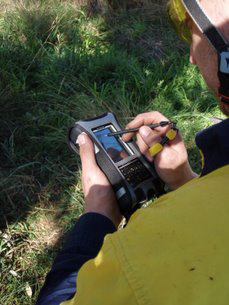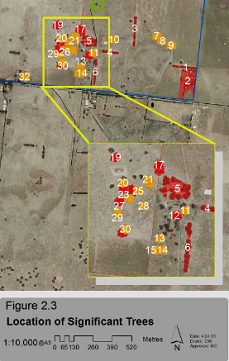Treetec provides advice and tree reports for planning applications, please contact us for a quote. Prices depend on the type of arboricultural report. Some councils require only a simple tree condition statement while others ask for tree data, hazard assessments, tree impact assessments and recommendations on how to minimise structural impacts on those trees being retained.
Some planning applications will require an ecological assessment or Net Gain Assessment and we can supply this also.
Pre-planning consultation

It’s recommended a preliminary tree assessment be undertaken early in the planning process to identify potential tree related restrictions. This would ideally involve a pre-planning, on site consultation with the arborist, designer and proponent. Significant / high value vegetation can be identified and plans can then be developed with this information to hand, this can avoid expensive re-design work and delays later on.
Categories of tree reports
Some planning bodies will request a Tree and Site Condition Report; effectively an arborist report detailing the condition of the trees, and vegetation more broadly, as well as general site characteristics. The arborist is asked to provide an impartial assessment that gives the planning department adequate information to determine which, if any, trees on site should be protected. This type of tree report does not necessarily include recommendations.
Construction Impact Tree Reports detail which, if any, trees on site or on adjoining properties may be impacted by a proposed development and the likely degree of impact on those trees. Also the arborist will outline which trees are of high amenity and therefore should be protected. Where applicable recommendations will be made in relation to tree protection measures (offsets) and possible construction methods that might be applied to ensure trees can be successfully retained within the vicinity of the development.
Tree related constraints
All trees are created equal….. however depending on Vegetation Protection Overlays (VPO’s), location, perceived value, tree size, species and condition some are more equal than others. Tree value will also be assessed in the wider context with consideration to the Ecological Vegetation Class (EVC) for the site and the ecology more broadly.
Trees can add significant value to a development project providing instant amenity however their presence can place restrictions on placement and sizing of a structure or sub-division boundary.
Prior to purchasing a property or commissioning plans ensure you have a good understanding of the likely tree related constraints the planning authority may impose and the relative value of the vegetation on site. The local council or Treetec can provide a summary of the various overlays in place.
A Treetec arborist can provide preliminary site inspections including an aerial tree assessment (climbing) if required.
Net Gain Assessments
Some developments, depending on scope and location, will trigger the requirement for a Net Gain Assessment. A Treetec ecologist can provide advice on whether a Net Gain Assessment will be required and a gauge on the likely outcome of that assessment as well as a quote to undertake the assessment and prepare an Offset Management Plan if applicable.
When it’s appropriate the net gain report can be combined with the arborist report keeping your costs to a minimum. There are also savings if the data for both reports can be collected during a single visit.
See our ecology section for more detail.
Design considerations
When planning you should identify high value trees or vegetation and avoid it, achieving this will facilitate a faster, cheaper more sustainable development….. unfortunately it’s rarely that simple.
Where avoidance of trees is not possible then minimise damage to those trees and plan for offsets; that is the replacement of lost flora. This principle of ‘avoid, minimise, offset’ is the key tenet of Victoria’s Native Vegetation Management Framework and consequently the various planning schemes embody this value. Victoria’s Native Vegetation Management Framework relates to indigenous vegetation however the principle has now been adopted more broadly and if the proponent of a development can demonstrate that this approach to tree management has been adopted it will increase the chances of favourable consideration from the planning department.
Tree Protection Zones (TPZ)

Within an arborist report from Treetec you will find reference to the Tree Protection Zone or TPZ for retained trees, this is a calculated exclusion area that allows for protection of canopy and roots; both the structural roots that give the tree stability and the smaller absorption roots. The radius of the TPZ is normally calculated for each tree by multiplying the Diameter at Breast Height (DBH) × 12. The minimum distance will be 2m and maximum 15 as stipulated in the Australian Standard 4970-2009 – Protection of trees on development sites.
Understanding this tree protection concept in conjunction with recognising high value trees should inform your plans and avoid unexpected problems that relate to vegetation.
Ideally there should be no encroachment into the TPZ of a retained tree however there are exceptions, below is an extract from AS 4970-2009:
Variations to the TPZ
General
It may be possible to encroach into or make variations to the standard TPZ. Encroachment includes excavation, compacted fill and machine trenching.
Minor encroachment
If the proposed encroachment is less than 10% of the area of the TPZ and is outside the SRZ detailed root investigations should not be required. The area lost to this encroachment should be compensated for elsewhere and contiguous with the TPZ.
Variations must be made by the project arborist considering relevant factors listed in (see standard)….
Major encroachment
If the proposed encroachment is greater than 10% of the TPZ or inside the SRZ, the project arborist must demonstrate that the tree(s) would remain viable.
The area lost to this encroachment should be compensated for elsewhere and contiguous with the TPZ. This may require root investigation by non-destructive methods and consideration of relevant factors listed in (see standard)……..
_________________________________________________________________________
A Treetec report will address these issues as they relate to your proposal and the trees on or near the site.
We strongly advise that an arborist be consulted early in the planning process, once higher value trees or vegetation is identified it is important to understand the Tree Protection Zone (TPZ) and Structural Root Zone (SRZ). We have created a free online calculator that can determine the DBH, TPZ and SRZ of a given tree –
